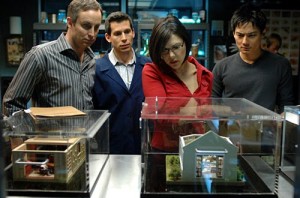Today I welcome back to TKZ my friend and fellow ITW member, Lisa Black. Lisa has one of the most unique day jobs, especially for a suspense writer. As she likes to describe it, she spent the five happiest years of her life in a morgue. She was a forensic scientist in the Cleveland coroner’s office where she analyzed gunshot residue on hands and clothing, hairs, fibers, paint, glass, DNA, blood and many other forms of trace evidence, as well as crime scenes. Now she’s a certified latent print examiner and CSI for the Cape Coral Police Department in Florida. Her books have been translated into six languages and one reached the New York Times mass market bestseller’s list.
I asked Lisa if any of her experience developed into a story and she related one of her first published works to me. She wouldn’t tell me where it was published, only that it was in one of those “sleazy true detective magazines” back in the day. Enjoy!
Joe Moore
——————–
Yet another case of a mild-mannered, suburban murdering mom
I wanted to write true crime before I even got into forensics. But since only the military had an internet back then, I had to find stories to  write about the old-fashioned way, via the library and newspaper indexes and microfilm and this wonderful window at the Justice Center where they had to give you copies of the basic dispositions of court cases (public record, after all). And one of the first stories I chose was the mundane yet chilling tale of Terri Sramek.
write about the old-fashioned way, via the library and newspaper indexes and microfilm and this wonderful window at the Justice Center where they had to give you copies of the basic dispositions of court cases (public record, after all). And one of the first stories I chose was the mundane yet chilling tale of Terri Sramek.
One summer night Terri called the Middleburg Heights police to tell them that she had returned from church to find her husband, William Sramek, gone. There were no signs of disturbance and nothing missing from the house. She went on all four local channels to plead for information. A MHPD detective happened to catch the news and immediately sensed that something was off about Terri Sramek. She just didn’t add up.
The case had indeed been assigned to him, and he promptly received a call from an FBI agent who knew nothing about William Sramek but a lot about Terri. The detective tried to follow his monologue: In Billings, Montana, Terri worked as an executive secretary for an insurance company which handled, among other things, the Miss Montana beauty pageant. Funds turned up missing. Terri and her boss invented a robbery and then even a new ledger, except for the wrong year. She pled multiple personality disorder but couldn’t fool the court and got 10 years, while telling one boyfriend she was actually in LA attending flight attendant school.
After her release she went right back to work—her type of work—for a Salt Lake law firm and met William Sramek. When the firm discovered $65K missing the couple moved to Cleveland. Terri found a job with a financial services firm…which then, somehow, lost $40K.
The FBI caught up with her on behalf of Utah, and she promptly went into the hospital with heart palpitations, though her doctor failed to back her up. But she was also pregnant, so Utah delayed enforcement of their warrant.
Now the Middleburg Heights detective found that Terri had been trying to sell William’s coins and responding to other men’s personal ads.
That didn’t sound good.
Exactly a week after he was reported missing, a police SWAT team searched the city surrounding the Sramek home. Rangers, the law enforcement body of the Cleveland Metropark system, searched the park areas on foot and on horseback.
The hunt lasted all day. They found nothing.
But Terri Sramek was arrested again, for not informing the probation authorities of her arrests. She didn’t know it yet, but she had just enjoyed her last day of freedom for a long, long time.
Salt Lake City reinstated the charges.
Then, in the middle of August, a birdwatcher pursued a bundle of plumage into some tall grass and found a decomposing body. The skull had lost almost all its flesh and had bullet holes in its base and forehead.
Terri’s lawyer, accompanied by the victim’s family’s private investigator, went to see her in jail.
For reasons known only to herself, Terri Sramek told the two men that she had indeed shot her husband. When William suggested they go for a walk in the park, she slipped a new .38-caliber automatic into her purse, next to a bottle of baby formula. They strolled through the pretty parks and argued about money. Then, with their baby strapped to her chest, Terri shot her husband in the head and face and left him to the elements.
The baby did not cry, Terri insisted—an unusual reaction for an infant—and Terri set off to dispose of the murder weapon.
The PI told the MHPD about this confession and they told the Rangers. Their turf, their murder.
The ranger looked at Terri Sramek and felt no sympathy for someone who could put her kid in a baby carrier and then kill the little girl’s father, leaving him where he lay so that weeks later the cops would have to spoon through his bodily fluids just to recover his teeth. The ice in her veins reminded him of the movie Black Widow, in which the character played by Theresa Russell researched and wooed rich men in order to kill them, carefully covering her tracks each time. She mates, then she kills.
In an interview the Montana detective also mentioned the movie, though it hadn’t even been made when he knew her.
In jail, tearfully, hesitantly, delicately, Terri Sramek promised to cooperate. She told them that she had thrown the gun in the water while walking along the lake shoreline somewhere around Huron.
But meanwhile, yet another suburb’s PD conducted a diver training exercise. They began at a beach but weather conditions were so ideal that they moved to the Rocky River, where what looked like a human hand startled one of the divers. It turned out to be a rubber glove containing a .38 caliber revolver. Zebra mussels, the scourge of the Great Lakes, had not yet attached themselves to its surface. They sent out a “gun found” teletype, which neither MHPD nor the Rangers received, but the head diver had read about the Ranger’s search for a gun in the paper; he told a Cleveland homicide cop who happened to be a friend of the ranger. Almost simultaneously both men called the ranger. The dive team then found more bullets, and Ohio BCI recovered the scraped-off serial number. It led to a gun store and a receipt made out to Terri Sramek.
Huron, incidentally, sits on Lake Erie about fifty miles to the west of the rivers of Rocky River. Even her confession came out half lies.
Terri skated on the embezzlement charges, cut her losses and pled, getting fifteen years to life.
She is still in jail.
When we invent villains for our books, we usually make them ingeniously clever, meticulous planners. They cross every t, dot every i, are voraciously ruthless. But the scariest killers are the real ones, the ones who aren’t criminal masterminds but making it up as they go along, the ones who have jobs and children and do dishes. The ones who seem as ordinary as white bread and yet feel entitled to take what isn’t theirs—including someone else’s life.
They’re the really scary ones.
—————-
Lisa Black’s latest thriller is CLOSE TO THE BONE, a story that hits forensic scientist Theresa MacLean where it hurts, bringing death and destruction to the one place where she should feel the most safe—the medical examiner’s office in Cleveland, Ohio, where  she has worked for the past fifteen years of her life. Theresa returns in the wee hours after working a routine crime scene, only to find the body of one of her deskmen slowly cooling with the word “Confess” written in his blood. His partner is missing and presumed guilty, but Theresa isn’t so sure. The body count begins to rise but for once these victims aren’t strangers—they are Theresa’s friends and colleagues, and everyone in the building, herself included, has a place on the hit list. Visit http://www.lisa-black.com/
she has worked for the past fifteen years of her life. Theresa returns in the wee hours after working a routine crime scene, only to find the body of one of her deskmen slowly cooling with the word “Confess” written in his blood. His partner is missing and presumed guilty, but Theresa isn’t so sure. The body count begins to rise but for once these victims aren’t strangers—they are Theresa’s friends and colleagues, and everyone in the building, herself included, has a place on the hit list. Visit http://www.lisa-black.com/


 promised that the “
promised that the “


 Spector case (which, oddly enough, wasn’t nearly as disturbing. But then, what happened to Lana Clarkson wasn’t as terrible as what was done to that little girl). We also had a fantastic presentation from a “Questioned Documents” examiner who explained exactly how easy it is to forge a signature, and what to do to combat that (sign your name over itself 2-3 times) and we toured the labs, including the rooms that hold stainless steel water tanks where guns are fired to match ballistics from crime scenes. Very cool. More information on the lab and the Crime Lab project is available
Spector case (which, oddly enough, wasn’t nearly as disturbing. But then, what happened to Lana Clarkson wasn’t as terrible as what was done to that little girl). We also had a fantastic presentation from a “Questioned Documents” examiner who explained exactly how easy it is to forge a signature, and what to do to combat that (sign your name over itself 2-3 times) and we toured the labs, including the rooms that hold stainless steel water tanks where guns are fired to match ballistics from crime scenes. Very cool. More information on the lab and the Crime Lab project is available 



